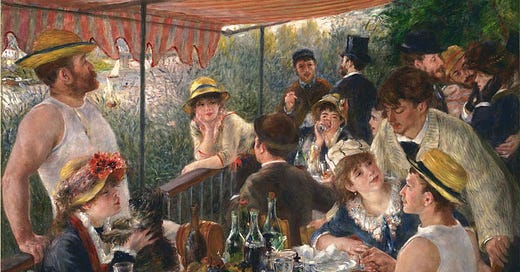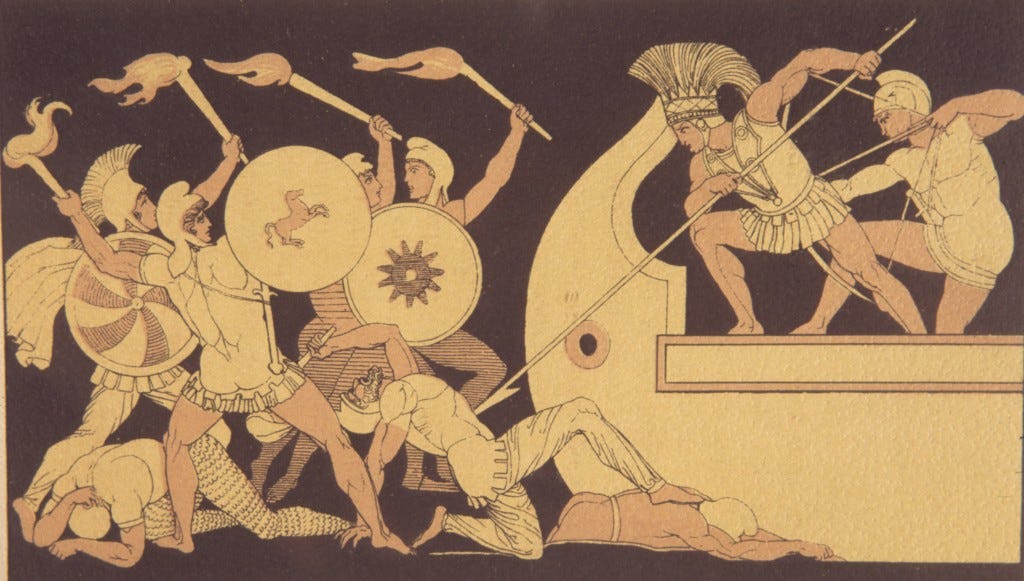In Pt. 1, I establish that art exists to give our lives shape. Elsewhere I also reflect on the overlapping nature of the true, the good, and the beautiful.

Artists throughout time have mused on the power of art to stir up desire. “One good thing about music,” Bob Marley says, “is that when it hits you, you feel no pain.” Art warms our senses, melts our emotions, and ignites our passion. The problem is, once that passion is lit, it needs somewhere to go. It needs careful tending, lest it burn out or move in an unsafe direction.
Great art keeps that passion burning safely like the lampstand does the flame. The shows we watch, the music we listen to, the books we read, they form us. They teach us what to appreciate. They lead us toward what we love. These days we have an overwhelming amount of content, but so little art. So much lights up our senses, but so little gives our life meaning. What happened?
Meaning without Pleasure is Painful
Throughout history and across every artistic movement, artists have battled over the conflicting impulses to create meaning and to evoke pleasure. The Ancient Greeks found Truth to be incredibly empowering when it came to creating Beauty. Polykleitos, for example, used math to create perfectly ratioed statues, figures that stun us even today. Goodness also plays a role in making works that endure, such as in the poetry of Milton, the paintings of Kahlo, or the music of Dylan.
But an overemphasis on creating meaning through art can suppress Beauty, causing the approach to backfire. Think of Philip Glass and his acclaimed but unloved “Music in Twelve Parts,” or the short-lived morality plays of the Middle Ages. Art without pleasure repels us rather than draws us in. It struggles to do its job because people don’t like it enough to stick with it. They may be compelled by something other than beauty, such as guilt or social incentive, but even that wears over time. The worst of it — thinly veiled lectures or preachy art — looks plain ugly.
Pleasure Without Meaning is Pointless
Oscar Wilde shocked the world when he declared that “all art is quite useless.” He formally divorced Beauty from any obligation to be truthful or moral. Who cared if art lacked sense or a purpose? Beauty was beyond these things. The new mission became “art for art’s sake.” The only concern now, as Walter Pater proclaimed, was “to burn always with this hard gemlike flame, to maintain this ecstasy.”
Today’s limitless content landscape realizes this beyond imagination. The average consumer, who once had to physically enter a venue for entertainment, is now exalted to the place of King Solomon, the greatest pleasure seeker of all time, with every indulgence imaginable right at his fingertips. We’ve got videos that will amaze you, videos that will shock you, videos that will make you tear with laughter! We’ve got people dancing, doing singing challenges, style flexes, crowd work, and pottery montages! We’ve got chiropractic crunches, body transformations, origin stories, sequels and prequels and reboots and spinoffs, joining into one relentless tidal wave of fun!
But have you ever watched someone scroll through content? Have you observed their reaction as the glow flickers with each swipe? Where is the shock? The awe? The tears? They look more sedated than stimulated. Their face hardly reflects the quick-cutting spectacle shining in their motionless eyes. When they finally put their phone down, if you were to ask them how they felt, they wouldn’t answer “awestruck,” or “shocked,” or “tickled pink!” They wouldn’t be sure of how they felt. They wouldn't even be sure of what they watched. Hours spent and little meaning (or memory) to show for it. And yet it wouldn’t be long before they picked up their phone and resumed scrolling, chasing pleasure like chasing the wind. We may have it all, but something is clearly missing. It’s written all over our faces.
Pleasure with Meaning is Purposeful
“The principle of art for art’s sake is a very good principle,” G.K. Chesterton comments, “if it means that there is a vital distinction between the earth and the tree that has its roots in the earth; but it is a very bad principle if it means that the tree could grow just as well with its roots in the air.”
Here Chesterton suggests that while Beauty ought to be recognized as distinct from Truth and Goodness, it shouldn’t be disconnected from them. Instant pleasures can only take us so far. Should they last long enough to awaken our spiritual hunger, how terrible would it be to find they have no food to offer it! No lesson from Truth to enrich us. No guidance from Goodness to protect us. Such unfulfillment would be enough to make us echo King Solomon’s lament that “all is vanity!”
Truth and Goodness nourish Beauty as soil and water nourish a tree. Philosophy, theology, rationality, morality, and ethics all contribute to our understanding of human existence; Beauty and the arts allow that faith to become sight. If you’ve ever wondered what makes great art great, it isn’t random. Chesterton reveals that “every great literature has always been allegorical — allegorical of some view of the whole universe. The ‘Iliad’ is only great because all life is a battle, the ‘Odyssey’ because all life is a journey, the Book of Job because all life is a riddle.”
Important Concepts in Sensuous Clothing
Great art points to something greater than itself. This is not a matter of high art versus low art. Bluey puts that matter to rest. This is a matter of pleasure and meaning acting together. Our spirits, like our minds and wills, crave instruction. “To whom shall we go?” asks the lost soul. We need artists “to present important concepts in seductive and sensuous clothing,” Alain De Botton suggests, “to combat our forgetfulness and coldness of heart.” The artist is called to give life shape; and by shape, direction; and by direction, meaning; and by meaning, hope.
Pair this reading with Part 1: Art as Form and The Triangular Door. Previously, I reflected on the possibility of real Beauty, and how artists and the religious can advance their own causes by becoming better friends.





